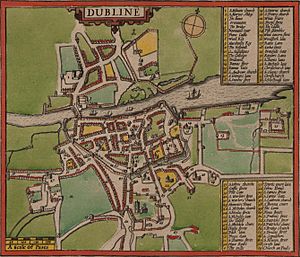Augustinian Friary of the Most Holy Trinity, Dublin facts for kids
| Monastery information | |
|---|---|
| Order | Order of Saint Augustine |
| Established | c. 1259 |
| Disestablished | 1540 |
| Dedicated to | The Most Holy Trinity |
| Diocese | Dublin |
| People | |
| Founder(s) | The Talbot family |
| Site | |
| Location | Dublin, Ireland |
| Visible remains | Underground, one subterranean wall in St. Cecilia St. |
| Public access | No |
The Augustinian Friary of the Most Holy Trinity was an important religious building in Dublin, Ireland. It was a priory, which is like a monastery, for a group of monks called the Augustinian Friars. They belonged to the Order of Saint Augustine. These friars were "mendicants," meaning they relied on donations and lived simply.
The friary was started around 1259 by the Talbot family. It was built on the south side of the River Liffey, in an area now known as Crow Street. Back then, it was just outside Dublin's city walls. The design of this friary was probably similar to another Augustinian priory in Clare, England.
Sadly, the friary was closed down in 1540. At that time, it was described as having a church with a bell tower, a large hall, and a dormitory where the friars slept. Even after it closed, the Augustinian friars secretly continued their work in Dublin. They are mentioned in city records until the late 1700s, when they were able to open a new church.
Contents
Discovering the Friary's Secrets
Not much is known about the Augustinian Friary today. We don't know exactly how big its land was or what all its buildings looked like. However, experts believe the friary's boundaries were around Temple Lane, Temple Bar, Fownes Street Upper, and Cecilia Street.
In 1281, a couple named Geoffrey FitzLeones and Joanna gave money from their land rents to the friary. This shows how people supported the friars back then.
What Maps and Digs Tell Us
The friary site is shown on John Speed's map of 'Dubline' from 1610. It's marked as number 11. Parts of the site have been dug up by archaeologists. These digs have helped us learn more about the friary.
In 1993, archaeologists found about 70 burials from the late 1100s to the 1300s. In 1995, they found parts of the friary's walls near Cecilia House. Then, in 1996, more digging revealed a section of a wall with a special arch and a corner tower. These discoveries help us imagine what the friary might have looked like.
Life at the Friary
We don't have a full description of this specific friary. But we know a lot about similar Augustinian friaries in England from the same time. This helps us guess what life was like here.
Mervyn Archdall, an Irish historian, wrote that this monastery was very important. He said it was the main college for all Augustinian friars in Ireland.
Buildings and Daily Life
The buildings of the friary alone covered about one and a half acres. They would have been set up like English Augustinian friaries, with many buildings around a central courtyard.
These buildings likely included:
- A large church for worship.
- Cloisters: Covered walkways that led to other buildings.
- A dining room where the friars ate together.
- Dormitory buildings where the friars slept.
- A kitchen to prepare meals.
- The Prior's house: The home of the leader of the friary.
- A building for sick and elderly friars.
- A bakehouse for making bread.
- A guesthouse for visitors.
- A house for students who were learning to become friars.
- A novitiate house for new friars in training.
- A house for lay brothers, who helped with daily tasks.
- A garden for growing food and herbs.
- A farm to provide food for the community.
This shows that the friary was a busy place, supporting many people and activities within its walls.


